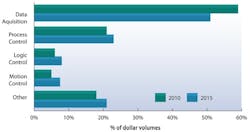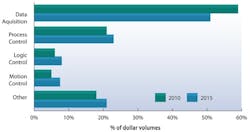Wireless Networking Breaking Down Barriers
Increased adoption of mesh networking and its self-healing capabilities could help to propel wireless networking to strong growth through 2015, according to recent research from VDC Research (www.vdcresearch.com). Market growth has been strengthened by technology enhancements that help to overcome concerns over reliability, latency and security, analysts say.
Growth of wireless networking in industrial facilities is driven by a variety of factors, however, including improved efficiency, cost reductions, increased productivity, and the ability to install wireless where wired solutions are impractical or impossible. Wireless networking reduces the majority of the cabling required, along with associated costs; it also allows easier add-ons, changes and removal of functions.
Despite the benefits of wireless networking, VDC Research does not expect the real emergence of the technology throughout the control hierarchy for most applications within the next five years, particularly for critical applications.
VDC forecasts the market for wireless networking products (access points, antennas, gateways, modems, repeaters, routers, switches, transceivers and standalone network management software) to grow from less than $400 million in 2010 to close to $1.3 billion in 2015.
Although data acquisition will remain the primary application served by wireless networking solutions, demand is growing most markedly for process, motion and logic control applications (see figure).
Fieldbus Foundation Enhances Specifications
The Fieldbus Foundation (www.fieldbus.org) made enhancements to its Foundation fieldbus physical layer technology, and states that the latest updates to the H1 (31.25 kbps) physical layer specifications will improve the robustness of fieldbus control systems by optimizing device interoperability and integration. End users will benefit from improved installation, commissioning and startups.
Enhancements include addition of a test procedure for isolated couplers to the existing Foundation fieldbus Coupler Test Specification, with registration of isolated couplers now possible; improvements to the H1 Physical Layer Conformance Test Specification, the most significant changes including the addition of a receive jitter test case and a device-coupler interoperability test; updates to the H1 Physical Layer Test Specification to remove obsolete profiles and align new references in the document with the current International Electrotechnical Commission (IEC) specifications, with coupler profiles also added to the specification; and miscellaneous updates to the Cable Specification.
"The Fieldbus Foundation's rigorous interoperability test and registration procedures thoroughly examine all aspects of a fieldbus device," said Stephen Mitschke, Fieldbus Foundation's director of fieldbus products. "The latest enhancements to our physical layer specifications will strengthen this testing and provide end users with greater confidence that registered Foundation fieldbus devices can be employed in a tightly integrated, interoperable control system architecture."
Implementation of the new H1 Physical Layer Test Specification Version 2.0 is not immediately required, although fieldbus device developers are encouraged to start using the specification as soon as possible. The updated specification will become mandatory with the next major release of the Fieldbus Foundation's Interoperability Test Kit (ITK).


